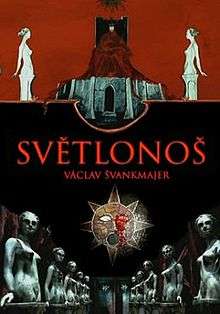The Torchbearer
The Torchbearer (Czech: Světlonoš) is a 2005 Czech animated short film written and directed by Václav Švankmajer. It is described as an allegorical story about rise to power.[1]
| The Torchbearer | |
|---|---|
 Film poster | |
| Directed by | Václav Švankmajer |
| Written by | Václav Švankmajer |
| Music by | Ondřej Ježek |
| Edited by | Martin Knejp |
| Distributed by | Bionaut |
Release date | 2005 |
Running time | 25 minutes |
| Country | Czech Republic |
| Language | Czech |
Švankmajer worked on the film for 5 years in his family studio Athanor. He mixed a medieval legend with fantasy genre and also used some techniques known from videogames. The film was influenced by films of Jan Švankmajer, the father of Václav Švankmajer.[2] The Torchbearer has won multiple awards.[3]
Plot
The film starts with a Town with a huge labyrinth and emperor sitting in his throne. A neverending circle of day and night occurs. Emperor dies one day and the circle stops until the new Emperor rules. A hero enters the town. He comes to a hall full of statues of women. He leaves the hall and enters the labyrinth. Statues come to life behind Hero's back and enter the Labyrinth where they set three traps for him.
Hero gets to a place where are two Doors with a guillotine hanged behind these doors. There is also a statue that controls Doors and Guillotine. The Statue doesn't let Hero go through the door unless he gets hit by the guillotine. Hero hesitates until a group of Rats stripping a bone in a cloth appear. One of these rats attack Hero and is throwned at the Statue. The rat destroys the Statue and Hero is allowed to progress further.
Hero gets to an arena and is attacked by a Flying Monster that is controlled by Statues. A great battle occurs. Hero gets some damage and the Monster gets the upper hand but Hero manages to cut one of strings that Statues use to control the Monster. The Monster falls and wriggles in agony. Hero brutally kills the monster and progresses further.
Hero gets to the third trap which are quickly moving walls. He tries to get through the trap but fails and almost dies. He eventually notices a hole in a wall. He sees two statues that control the moving Walls. Hero kills one of these statues while the other runs away.
Hero enters a huge doors behind the trap and gets to a hall full of Statues that welcome him with trumpets. He sees a white curtain on the other side of hall. He goes closer and a huge Throne appears from behind the Curtain. Emperor's Skeleton is seen sitting in the Throne. Two Statues throw him out of the throne and rats appear to drag Emperor's body away. Hero takes Emperor's place and is Crowned the new Emperor. He sits in the Throne but suddenly multiple Hypodermic needles appear and impale him. The Throne disappears behind the Curtain. Audience can see Hero's blood flowing into a Heart that starts beating which sets a machine to work and a Circle of Day and Night occurs once again. The film ends with a scene very similar to the one it started with.
Reception
The film has won an award at a student film festival Fresh Film Fest Karlovy Vary for the Best animated film in 2005. The Film also gained a Honorable mention.[4]
The Torchbearer also won Kristián Award for the best animated film at Febiofest 2006.[5]
The Film was shown at Anifilm Festival in 2012. The film was likened to works by Jan Švankmajer, the father of Václav Švakmajer.[6]
References
- "Světlonoš". Česká Televize. Retrieved 2 July 2015.
- Jiřiště, Jakub. "Mytická pouť k demytizaci světa". 25fps.cz. Retrieved 2 January 2018.
- "PĚT STATEČNÝCH FAMÁKŮ (Nová generace české animace)". Warsaw Czech Center. Retrieved 3 July 2015.
- Míšková, Věra. "Studentský Fresh Film Festival nachází své postavení". Novinky.cz. Retrieved 2 July 2015.
- "Slámovo Štěstí bodovalo i na Febiofestu". Aktuálně.cz. Retrieved 2 July 2015.
- Zahradníková, Andrea. "Animovaný film nabízí i mutanty, děsivé fantazie a potoky krve". Deník.cz. Retrieved 2 July 2015.
External links
- Official Site
- The Torchbearer at CSFD
- The Torchbearer at IMDB